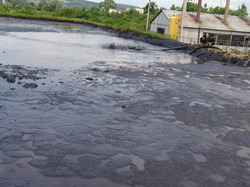 Hydrocarbon Contaminated Sludge Pond
Hydrocarbon Contaminated Sludge Pond A site's bioremediation potential is first evaluated by determining the types and extent of pollutants present. Following site characterization, a remediation plan is developed based on the pollutants present, site characteristics, environmental variables, and cleanup time frame.
The compounds present may include some organics that are slow to degrade or have a degree of toxicity/quasi-toxicity to many microbes. In these cases, the time for cleanup can be reduced by first adding the mixing/aeration and fertilizers as used in biostimulation; then on-site time can be further reduced by avoiding the adaptation and lag phase growth of indigenous microbes via the use of bioaugmentation.
Using data from the site characterization, microbiologists can develop a microbial blend containing organisms having specific metabolic pathways for degrading target organics. Another consideration is the ability of organisms to produce biosurfactants, that improve activity by enhancing hydrophobic compound solubility. The extent of the benefit depends upon the "fit" of the microbial inoculum used and the general state of indigenous microbes already at the site. Overall, usually the decrease in on-site remediation activities including labor, lab testing, and risks associated with an active remediation project can pay for the use bioaugmentation.

 RSS Feed
RSS Feed